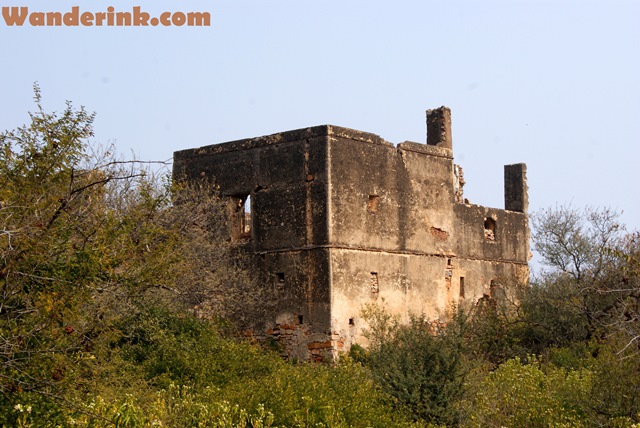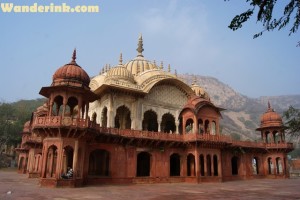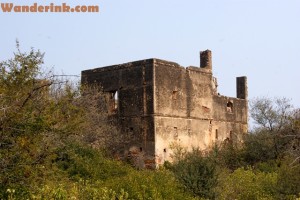The Siliserh Palace 15 kilometres south-west of Alwar was built by Maharaja Vinay Singh in 1845. But you can attribute it to the colourful Maharaja Mangal Singh who ruled from 1874 for almost two decades if you are not finicky about historical facts. And if you believe that a dash of romance – a doomed one even, or especially a doomed one – will lend the renovated ramparts, the newly painted bastions and bartizans an old-world intrigue. The caretaker cum guide of the palace which is now a heritage hotel run by the Rajasthan state tourism department certainly did. And after all the un-palace-like rabble rousing – the Siliserh Lake which lies lapping around most of the palace is a popular water ski destination – of the day and into-the-evening babble of the babus I was desperate to reinstate some regal moorings to the magnificent, rambling structure which now lay white as a dried bone under a full moon. We sat on the steps leading to the quay where the boats, their outboards removed for the night, bobbed like imperceptible nods on inky blue water, the moonlight dappling a million shimmery streamers.
Mangal Singh was out hunting one day in the forest near the village of Kishanpur where he chanced upon Silika the very pretty daughter of the village chief. The dashing king fell in love and pursued the belle ardently. Soon enough the jejune lass fell into his arms – which was how the village chief found them. The glad-eyed king who was not looking for more than a fling was at first reluctant to marry Silika; it also didn’t help that he already had other wives at his palace in Alwar. But eventually Mangal Singh did take Silika to Alwar. But as fate would have it, their firstborn died soon after birth. The heartbroken Silika took permission from the king to return to her village. Now a queen is not supposed to live in humble agrarian surrounds, or so deigned the king and built the palace for her. Silika breathed her last before long which my storyteller assured me was because the king had by then stopped coming to see her. Quite possible, I thought, those were the good old days – people used to succumb to broken hearts. After the jeremiad I looked over my left where I could see a part of the balustrade at a distance made of solid sandstone ashlars, overlooking the lake, which drew a perimeter around the palace berm. There I espied Silika, leaning over, straining her ears for the hoofs pounding in the distance, the occasional screeches of the barouche. Or maybe it was the beer. But the Siliserh Palace became a real palace again, mystery and intrigue intact.
Quiledaar ki Haveli
(This is originally from my guidebook ‘Experience Agra and around on the road.’)
As you come out of the Alwar Fort (Bala Quila), you pass by a dilapidated structure with hollows in place of windows and remnants of two columns or pillars that point upwards like questioning fingers. This is the ‘Quiledaar ki Haveli’ (or the palace of the caretaker) which is not marked on any tourist itinerary possibly for the lore associated with it. But Pushpendra Saini, local boy and tourist guide is only too eager to share the foxy yarn. This caretaker played a pivotal role in the ‘taking’ of the Bala Quila which was originally under Maharaja Suraj Mal of nearby Bharatpur. Suraj Mal was a bad paymaster and didn’t even clear pending salary dues to his soldiers. Pratap Singh, came to know of this disgruntled bunch and bribed the quiledaar to prevail upon the soldiers manning the fort to come out – weapon-less – in batches of 12. Probably on offer was a price to switch sides. All 600 soldiers who were entrusted with guarding the fort were killed by Pratap Singh and party. “The fort was thus won without a fight,” Pushpendra says in a tone that makes light of a tale of conniving and gruesome mass murder. Well, as they say, all is fair in…
The three Ms: Then, Pushpendra is a lad of many legends including some urban ones as well. “Do you know what’s most popular in Alwar?” He goes on without waiting for an answer. “They are the three Ms – mali (gardener), mawa (milk cakes) and machhar (mosquito).” If the narrative on how the fort was taken doesn’t have any historical proof, the second one had and a living one at that – Pushpendra himself. “I am a Saini and we are originally from the mali community,” he says laughing. Pushpendra knows Alwar like the back of his hand, is affable and speaks okay English and claims to speak Spanish as well. “I am waiting for a party from Spain today evening,” he said probably to hasten up things. He can be contacted at 0-8094774072. Email: peps.alwar@gmail.com
Now, if there could be a fourth M it would be the Musi Rani ki Chhatri.
Musi Rani ki Chhatri
After Orchha I was sure that I had my share of chhatris – cenotaphs – to last a lifetime. So I was in two minds about a longish walk over the smouldering sandstone pathway that led from the City Palace, past an open enceinte which was converted into a cricket ground and a slime-crusted pond to the Musi Rani cenotaph. “Many of the advocates from the court (which worked out of the City Palace) and peons and petitioners also join for a game – which is played by the over,” my guide told me as we walked past. The IPL format further IPL-ed down, both boundaries and wickets marked by flurries of expletives.
But the chhatri was enchanting, a solemn reminder of the exceptional beauty, the life and sacrifice of the eponymous queen. The red sandstone and white marble architecture stood elegant and austere under the midday sun though hemmed in by the stagnant pond, a clump of deciduous trees and unbridled encroachment. The hilltop Alwar Fort stood in the background enamoured by its prettiness. Both the floors were a byzantine layout with florid archways opening in all directions, leading everywhere. An apt design for an impromptu recital by a dancer in afterlife. Musi Rani was a court dancer. She was very young, her beauty was renowned all over the kingdom and the courtesans envied her talents as well as her beauty. Raja Bakhtawar, son of Alwar founder Pratap Singh, was very old when he was captivated by Musi’s charm. She married Bakhtawar knowing very well that her years as queen were numbered and she would soon have to follow the king to his pyre.
Which she did.

















Cenotaphs are grim reminders. Your blog too is.
Never let them fade away, yes?